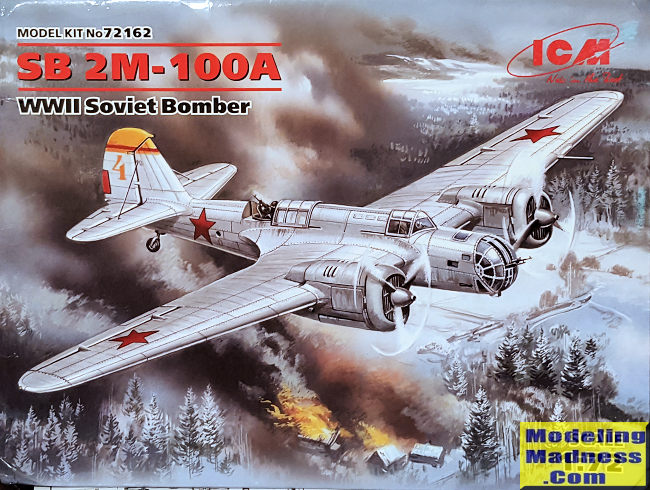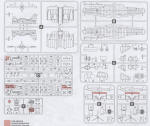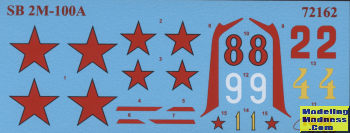
ICM 1/72 SB-2M-100A
| KIT #: | 72162 |
| PRICE: | $ |
| DECALS: | Four options |
| REVIEWER: | Scott Van Aken |
| NOTES: |
. |

| HISTORY |
The Tupolev ANT-40, also known by its service name Tupolev SB (Russian: Скоростной бомбардировщик – Skorostnoi Bombardirovschik – high speed bomber) and development co-name TsAGI-40, was a high speed twin-engined three-seat monoplane bomber, first flown in 1934. The Tupolev design was advanced but lacked refinement, much to the dismay of crews, maintenance personnel, and Stalin, who pointed out that "there are no trivialities in aviation".
Numerically the most important bomber in the world in the late 1930s, the SB was the first modern stressed skin aircraft produced in quantity in the Soviet Union and probably the most formidable bomber of the mid-1930s. It was produced in the Soviet Union and was also built under license in Czechoslovakia. Many versions saw extensive action in Spain, the Republic of China, Mongolia, Finland and at the beginning of World War II against Germany in 1941. It was also used in various duties in civil variants, as trainers and in many secondary roles. Successful in the Spanish Civil War because it outpaced most fighters, the aircraft was obsolete by 1941. By June 1941, 94 percent of bombers in the Red Army air force (VVS RKKA) were SBs.
The SB 2M-100 was the first production model. Wing area increased to 56.7 m2 (610 ft2). Equipped with Klimov M-100 engines (the Hispano-Suiza 12Y built under licence) driving two-bladed propellers. The SB-2M-100A had the newer M-100A engines of 642 kW (860 hp), driving three-bladed propellers. Produced from late 1936. Sometimes unofficially referred to as the SBbis.
| THE KIT |
 I
tend to order a lot of kits from overseas. Despite the current fairly long wait
due to a paucity of flights, it does save money compared to getting them from a
US mail-order shop. The downside is that often the kit box will take a bit of a
hit during transport as frequently these kits are simply put into a bubble back
to save weight. Hence the more reasonable postage. This one arrived from Ukraine
with all four corners nicely rounded off but with the contents totally unharmed.
I
tend to order a lot of kits from overseas. Despite the current fairly long wait
due to a paucity of flights, it does save money compared to getting them from a
US mail-order shop. The downside is that often the kit box will take a bit of a
hit during transport as frequently these kits are simply put into a bubble back
to save weight. Hence the more reasonable postage. This one arrived from Ukraine
with all four corners nicely rounded off but with the contents totally unharmed.
ICM's kit is nicely molded with just a touch of flash on a few parts. There is actually a lot of plastic in the box. The kit is also rather oddly broken down with the fuselage in three major segments; the nose, wing area and rear fuselage/tail section. There are some tabs to help you get them aligned, but care will be needed.
One starts by building up bombs then assembling the center section. This includes a pair of hefty spars and building the bomb bay along with the lower gunner's position. The pilot's seat is attached to the front spar piece. Then one does the nose section which has the bombardier's section as well as the pilot's controls. The tail piece has the rear upper gunner's slot as the radio operator's position.
Then construction moves to the engines and nacelles.
The three fuselage pieces are glued together followed by the engines, outer wing
panels, and the tailplanes. All of the flight control surfaces are separate so
you can pose them if you wish. The last two construction steps consist of
attaching clear bits and guns along with the landing gear and the bomb loads.
Main gear doors and bomb bay doors are molded closed so will need to be cut. The
kit also provides skis if you want to go that route.You also have a considerable
variety of ordnance that can be carried both in the bomb bay and in external
racks. Those of us who are lazy will model the bay doors closed.

Instructions are well done with generic color information provided throughout the build. Four markings options are given. One is from December 1939 in either aluminum or light grey with a yellow fin tip. Another is from June 1940 in the same silver or light grey with a fairly dense mottle of field green over all upper surfaces and fin. With dark green over light blue is a plane from the summer of 1941. Finally the ski mounted option in aluminum or light grey from January 1940.
| CONCLUSIONS |
| REFERENCE |
https://en.wikipedia.org/wiki/Tupolev_SB
July 2020
Compyright ModelingMadness.com. All rights reserved.
If you would like your product reviewed fairly and fairly quickly, please contact the editor or see other details in the Note to Contributors.
Back to the Main Page Back to the Review Index Page Back to the Previews Index Page